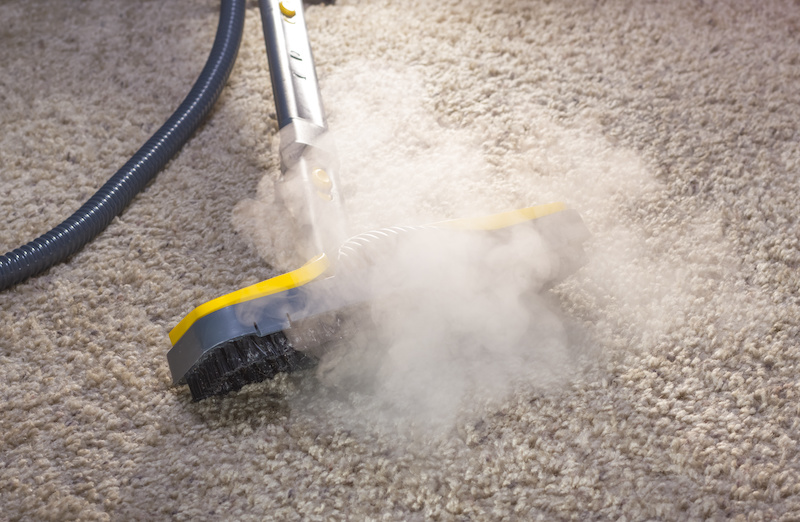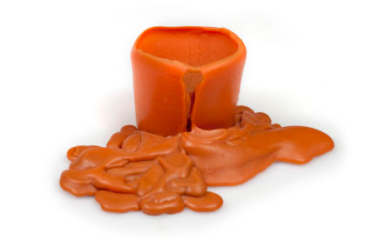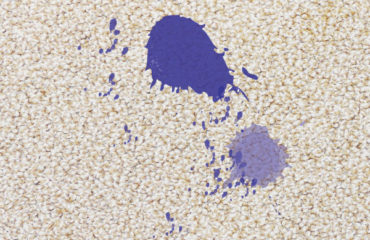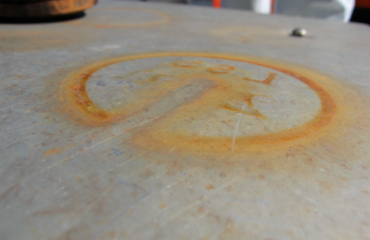Carpet cleaning with a traditional steam cleaning system can be challenging and often cause irreparable damage to your carpets. It’s easy to over-shampoo or over-saturate the carpet, which can deteriorate carpet fibers, leading to costly replacements. Not to mention the hassle caused by wet carpets and extensive drying times if you have pets or young children.
Another option to get rid of tough stains is to try dry cleaning carpets on your own. With the right materials, carpet dry cleaning is a relatively simple process that is better for your carpet and often delivers a superior clean than steam cleaning. If you’re wondering how to dry clean carpet at home, these four step-by-step methods are guaranteed to thoroughly clean and sanitize your carpets quickly and safely for better home health.
Method 1: Using a Dry Cleaning Compound
1. Prep the carpet with a pretreatment product
High-traffic areas regularly see tough stains. Before cleaning, spray stained areas lightly with a pretreatment product. The active ingredients in the pretreatment spray will start breaking down dirt and other stains, allowing them to lift off more easily when you dry clean.
If your carpet doesn’t have any heavy stains, skip to the next step.
2. Use a dry cleaning detergent on carpet
Carefully cover the entire carpet with a light layer of the dry cleaning compound using a kitchen sifter, cup, or measuring cup. Apply a thicker layer of the dry cleaning compound powder to deeper stains and high traffic areas.
Apply the powder in sections, moving from one side of the room to the other, and try to minimize stepping on it, so you aren’t tracking the cleaning compound through the rest of your home. Wash your sifter or cup when you are finished to remove any dry cleaning compound before using them in cooking. Alternatively, keep the sifter with your other cleaning items, only using it for carpet dry cleaning purposes, to avoid contaminating your food.
Carpet dry cleaning powders are available online and at local stores. Consider purchasing a dry cleaning kit, so you get a spray, the powder, a sifter, and a brush.
3. Gently brush the powder across the carpet using a soft-bristled scrub brush
The powder needs to be worked gently into the carpet to access the deeper carpet fibers and the layers of backing to remove oil and grime build-up. Don’t be too forceful with your brushstrokes since too much force can damage the carpet threads. Make sure to move the brush over the carpet several times in different directions.
To protect your back, use a carpet brush with a long handle so you can stand comfortably. You can also use kitchen scrub brushes or upholstery brushes from a vacuum cleaner.
4. Let the powder sit for 30 minutes
The dry cleaning compound needs time to activate, so let it sit for about 30 minutes. This will help the compound penetrate deep into set-in stains, so your clean is more effective. Feel free to leave it 15-20 minutes longer than recommended if your carpet is badly stained.
While you wait, it’s okay to walk on the carpet, keep young children and pets out of the room. Most dry cleaning compounds are considered non-toxic, but it’s best not to risk ingestion as with any cleaning product.
5. Once the powder is dry, vacuum as normal
After at least 30 minutes, you can vacuum the dry cleaning powder with your vacuum cleaner. You want to get up as much of the compound as possible, so you may need to go over the treated areas more than once and frequently empty the vacuum canister of the powder.
If you notice that your carpet is still stained, repeat the process with more powder or a different compound. This isn’t unusual if you have tough set-in stains.
Method 2: Applying an Encapsulant
1. Thoroughly vacuum the area
Thoroughly vacuum the area to pick up any loose dirt, dust, and other debris. Once it’s applied, the encapsulant could force any remaining debris to soak deeper into the carpet, or it could interfere with the encapsulant reaching the carpet.
2. Add hot water to the encapsulant to diffuse it in a pump sprayer
Encapsulants are powerful liquid cleaners that, when added to hot water, effectively remove carpet stains. Be careful when adding the encapsulant to the hot water; it can damage your carpet if you use too much. Carefully read the manufacturer’s directions. Even though water is added to the encapsulant, this is still considered a dry cleaning method because it is low-moisture.
3. Lightly spray the encapsulant onto the carpet
Before spraying, activate the pump sprayer by pulling the pump up and down until you feel resistance. Then hold the spray nozzle about 6” away from the surface of the carpet and sweep it slowly and steadily across the carpet, working your way through the room.
The encapsulant is safe to step on, but try not to so it can stay on the carpet and not get absorbed into your footwear or on the bare skin of your feet and tracked to other areas.
4. Let the carpet soak for about 15 minutes
For the encapsulant to loosen dirt, leave it undisturbed for at least 15 minutes. Removing the encapsulant too early makes it less effective, but you can use a dry cloth to remove excess moisture after the 15 minutes have passed.
5. Use a soft-bristled broom or brush to work the cleaner deeper into the carpet
Move from one end of the room to the other, using the broom to agitate the carpet fibers and loosen any stubborn stains. Make sure you brush everywhere you put encapsulant, so the dirt rises to the top.
If you can, use a carpet grooming brush with a long handle or a clean broom so you can move efficiently without bending over. Smaller brushes will require more time for large spaces, so save those for spot treatments.
6. Thoroughly vacuum the carpet
Make sure to thoroughly vacuum the carpet to remove all the dust, dirt, and cleaning compound residue.
Repeat the process if necessary, using more encapsulant or a stronger vacuum. You can rent a commercial vacuum at a hardware store for more suction.
Method 3: Spot-Cleaning with Vinegar and Baking Soda
1. Cover the stain with a generous layer of baking soda
It won’t harm your carpet, so cover the stain completely. Baking soda will also neutralize any odors associated with the stain, making it a great spot-treatment option for pet stains.
2. Use white vinegar to activate the baking soda
Gradually add one tablespoon of distilled white vinegar over the baking soda, and watch it react to the baking soda to form a solid paste.
3. Use your fingers or a soft-bristled brush to work the paste into the carpet
The paste needs to be worked into the carpet fibers to reach deeper than the surface stain, but don’t scrub too hard, or you’ll risk damaging the fibers, as baking soda is mildly abrasive. Move your fingers or the brush in small circles.
4. Let the paste sit overnight
The paste will begin drying immediately when exposed to air. Leave it until it is completely dry. When it reaches the consistency of sand or dust particles, it is safe to remove the baking soda.
5. Vacuum the dried paste
You may need to run the vacuum over the paste several times to pull it up completely.
Deep set-in stains may require additional treatments. If the stain is still present after multiple treatments, try using an encapsulant, which is more powerful.
Method 4: Buy Professional Dry Carpet Cleaning Equipment
For about $1,000, you can purchase your own professional-grade dry carpet cleaning equipment to use at home.
You’ll need to purchase the following:
- The DryMaster Master Bro – Upholstery & Auto Soil Extractor currently on sale for $750
- The DryMaster GlideMaster™Single-Jet, 10″ Stainless Steel Wand currently on sale for $295
- DryMaster Stainless Steel Upholstery Tool with 342AC 8′ Hose Assembly currently on sale for $129
Dry Carpet Cleaning Tips and Warnings
Carpet dry cleaning can be tricky. Keep these tips in mind as you consider dry cleaning your rug at home:
- Solid stains, like mud, must be carefully scraped away from the carpet before you attempt any dry carpet cleaning method.
- Set-in stains are more difficult to clean, so it’s best to treat them immediately by blotting liquids with a clean towel and picking up any solids.
- Each substance reacts differently to different cleaning ingredients, so you may need to try various methods for stubborn stains. Vinegar works well with most stains, while isopropyl alcohol or dish soap may work better with others.
- Contact a professional if you try multiple treatments and still can’t get the stain removed from your carpet.
Things You’ll Need
When dry carpet cleaning, make sure you have the right tools for the job before you begin any kind of treatment.
- When Using a Dry Cleaning Compound:
- Stain pretreatment spray
- Carpet dry cleaning compound
- Soft-bristled brush
- Vacuum
- When Applying an Encapsulant
- Encapsulant compound
- Pump sprayer
- Soft-bristled brush
- Vacuum
- When Spot-Cleaning with Vinegar and Baking Soda
- Baking soda
- Distilled white vinegar
- Spray bottle (optional)
- Soft-bristled brush
- Vacuum cleaner
Contact DryMaster Systems for Information about Dry Cleaning Carpets
Dry cleaning carpet at home can still leave behind set-in stains. If you’ve attempted unsuccessfully to your carpets yourself, contact one of DryMaster Systems’ affiliates for a professional clean. If you are interested in learning more about how to start your own DryMaster Solutions carpet dry cleaning affiliate, including startup costs, please fill out this form.




